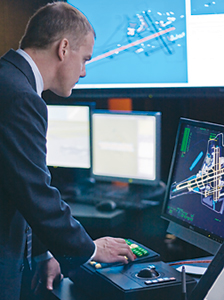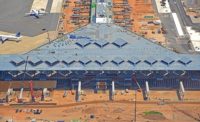
Embry-Riddle A researcher tests one of the hightech aviation systems at Daytona.
|
Daytona Beach International Airport is serving as a NextGen National Test Facility for implementing and evaluating new safety, ground-management and air-traffic-control systems.
The Federal Aviation Administration has set a goal of upgrading the country’s air-traffic-management system by 2025, says Christina Frederick-Recascino, vice president for research at Embry-Riddle Aeronautical University of Daytona Beach.
“We can try out all the ideas here, and then we slide out to the busier airports and say, ‘It looks like this will work; you try it out,’” says Ian Wilson, project principal investigator. Along with a $2-million grant from FAA, the project has attracted nearly $4 million of private funding. Testing of technologies will occur over the next five to 10 years.
NextGen would provide more capacity on existing runways, which “means less pressure for new runways,” notes Carlos Maeda, aviation services program manager for PBS&J, Tampa. “Maybe airports will be able to fit more runways into existing airfields.”
General aviation represents about 96% of the 290,764 annual flights at Daytona Beach airport. “This airport turns out to be a perfect location for this,” says Arlene Smith, assistant to the airport director of aviation. “We don’t have a heavy commercial-carrier presence, so it’s easier for testing to take place.”
Researchers are testing systems that will enhance communication between pilots, air-traffic controllers and ground workers, says Wilson. They are also assessing methods of sequencing aircraft during thunderstorms. In Florida, controllers typically direct pilots around weather, Wilson says. But in areas with more crowded airspace, thunderstorms can wreak havoc. Controllers may route aircraft farther from a storm than necessary due to hours-old information. More precise forecasting of where hail, lightning or icing may occur could change that.
Other test aspects include an integrated flight-planning program that allows aircraft to taxi and take off without queuing up, as well as a four-dimensional trajectory surface-surveillance system that enables controllers to watch tarmac traffic. The team is testing a design-support tool to assist controllers in sequencing aircraft into the airport. It would allow continuous descent and thus may help each plane save about 1,100 lb of fuel on approach.
The researchers have simulated the program for use at Atlanta and will try it with real aircraft at Daytona Beach. They will evaluate different ways to display future weather information and other data.
Yet another test involves a virtual tower that will offer digital displays of what is happening on the runway and in the air. In the future, controllers might work from an underground bunker instead of a tower.
 Related Links:
Related Links: 

Post a comment to this article
Report Abusive Comment